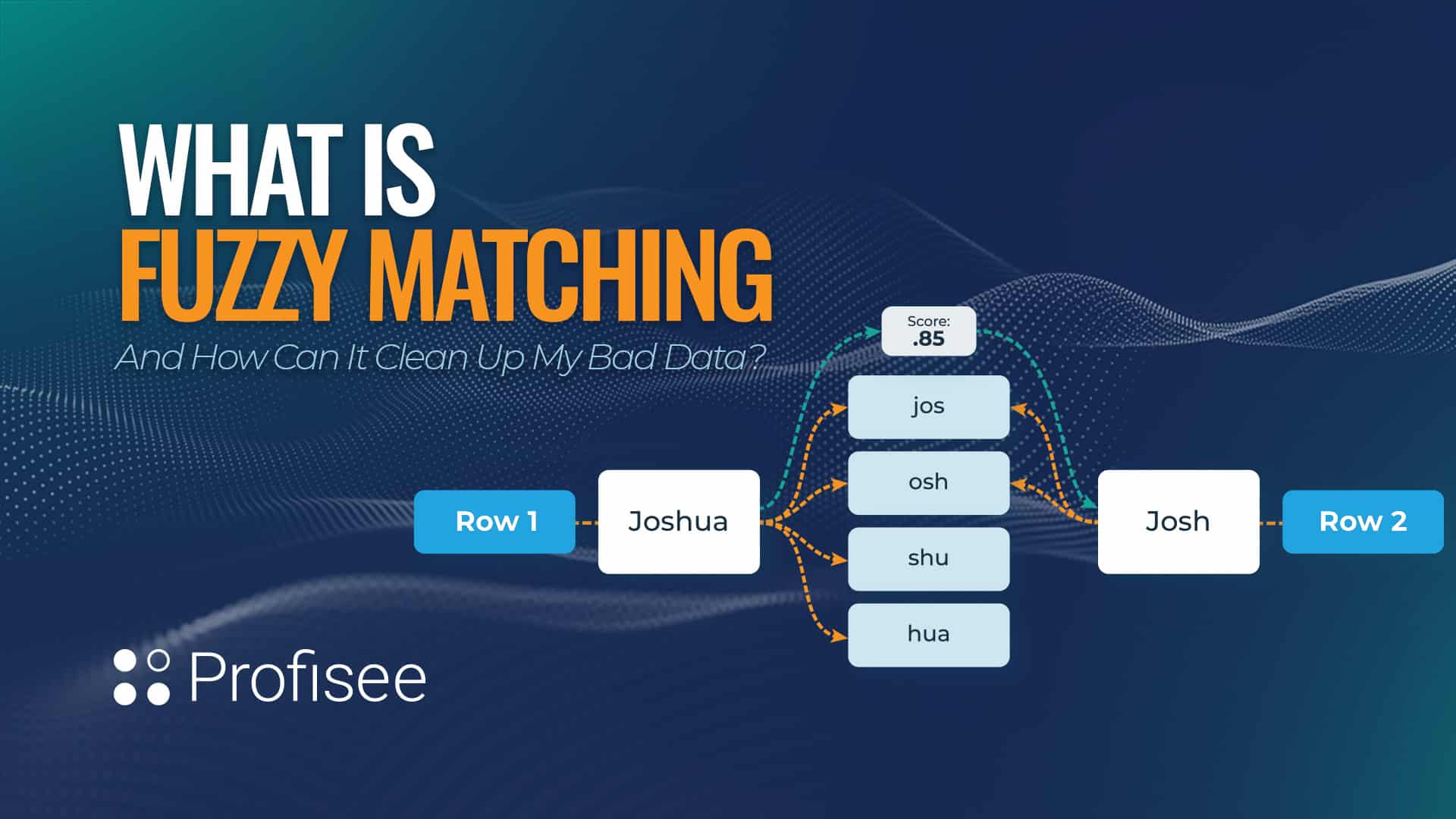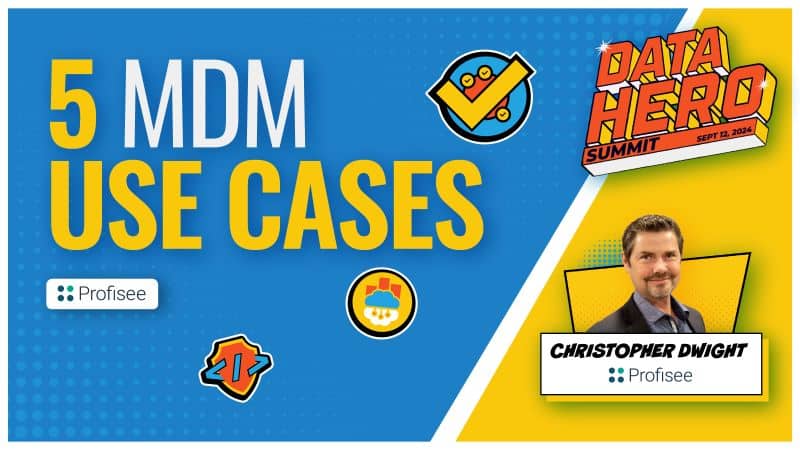Table of Contents
- What Is Fuzzy Matching?
- How Do Fuzzy Matching Algorithms Work?
- When Is Fuzzy Matching Better Than Exact Matching?
- How Is Fuzzy Matching Used in Different Industries?
- How Can Fuzzy Matching Be Used to Fix Data Quality Issues?
- What Kinds of Fuzzy Matching Algorithms Are There?
- How to Optimize Your Fuzzy Matching Algorithm
- Fuzzy Matching With Python
- Python Fuzzy Matching Algorithm Challenges
- Automated Fuzzy Matching
- Matching is Only the First Step
- Frequently Asked Questions About Fuzzy Matching
Updated December 4, 2024
According to a recent Gartner article, 84% of customer service and service support leaders cited customer data and analytics as “very or extremely important” for achieving their organizational goals in 2023. But if companies are unable to make sense of that data — and, more importantly, know the insights derived from it can be trusted — bad data can become a brick wall standing in the way of their most strategic initiatives.
In this article, we’ll explore fuzzy matching as a way to help you improve data quality. You’ll learn what fuzzy matching is, some commonly used algorithms for fuzzy matching, how fuzzy matching compares to other forms of matching and more.
What Is Fuzzy Matching?
Also known as approximate string matching, fuzzy name matching or fuzzy string matching, fuzzy matching is an AI and machine learning technology that identifies and matches similar or partially matching — but not identical — elements in data table sets.
It’s particularly useful when correcting datasets containing typographical errors and spelling or formatting inconsistencies or when comparing data from multiple sources. Fuzzy matching algorithms calculate the similarity between two records and convert them into scores to determine their similarity levels before placing them into a specific dataset.
This is a foundational first step in building a matching strategy and a core building block of the golden record management found in commercial master data management (MDM) platforms.
How Do Fuzzy Matching Algorithms Work?
We’ll go into greater detail about fuzzy matching algorithms later in this article, but first, a look at the basics of how fuzzy matching works. Note that, while these are common approaches you can take to fuzzy matching, Profisee uses its own algorithm to perform fuzzy matching.
Fuzzy matching algorithms consider several factors when matching separate records including:
- Character Similarity: The degree of resemblance or likeness between individual characters within the text.
- String Distance Metrics: Mathematical algorithms that are used to quantify the difference or similarity between two strings of text. For example, some fuzzy matching tools use the Levenshtein distance which measures the minimum number of single-character edits required to transform one string into another.
- Phonetic Similarity: The degree of similarity between two words or strings based on pronunciation and how they sound to the ear when spoken out loud.
- Token-Level Matching: The process of comparing or matching individual units (tokens) of data within a defined dataset. Tokens often represent words, phrases or sequences of characters.
A common example of fuzzy matching would be matching and/or grouping customer records. With manual data entry and formatting standards, there are resulting errors or differences.
Although there might be two separate customer records with one filed under “Jane Depp” and the other under “Jayne Dep,” fuzzy matching can look at the similarities between other pieces of the records to determine if they are for the same customer. Fuzzy algorithms can determine they are likely the same person even if they aren’t an exact match in the source system.
When Is Fuzzy Matching Better Than Exact Matching?
While exact matching is useful for comparing and matching identical data precisely, it serves no purpose if enterprise data is messy or inconsistent. It does not allow for any variations or differences and requires an exact match.
Exact matching is used when the data is expected to be consistent and uniform for elements like numbers, text strings or categorical variables. The process comes in handy for things like joining datasets, data validation, filtering, querying and aggregating data. Fuzzy matching is for those data elements that are similar but don’t quite line up with one another.

Fuzzy matching is especially useful for elements that comprise a customer 360 view, including customer names, addresses or product descriptions that are similar or duplicate. It takes differences into consideration and looks for slight differences in spelling, formatting or abbreviations. This approach is also a viable option when searching or retrieving information for instances where exact matches are unavailable or unnecessary.
It can fill in the gaps for certain data connections or relationships that may otherwise be lost with exact matching. If John and Jane are married and live at the same address, then fuzzy matching can see the identical location and connect that they are two separate customers living together and, depending on the business, making joint purchases. This can alter certain marketing or sales opportunities for some organizations with specific customers.
How Is Fuzzy Matching Used in Different Industries?
Fuzzy matching is used across industries to address data inconsistencies, but some industries use it in unique ways.
- Finance: Fuzzy matching aids in fraud detection by identifying suspicious patterns and anomalies in transaction data, helping protect customers from identity theft.
- Retail: Retailers use fuzzy matching to enhance customer experience by merging duplicate customer records across systems for more personalized shopping. This is known as customer 360.
- Healthcare: Healthcare organizations use fuzzy matching to link patient records across different systems, ensuring comprehensive patient information is available to providers. This is also done with provider data to make it easier for patients to find the right care through their patient portal, for instance.
- Manufacturing: Manufacturers use fuzzy matching to create consolidated views of their suppliers (supplier 360) to help consolidate contracts and negotiate better terms, reduce excess inventory at factories and maintain more accurate inventory counts.
How Can Fuzzy Matching Be Used to Fix Data Quality Issues?
Fuzzy matching is often used during the data cleansing process of data deduplication — a crucial step for any digital transformation or strategic initiative. When finding approximate matches between similar records, it identifies and resolves inconsistencies, inaccuracies and discrepancies. Without tackling these issues, your enterprise’s data quality is bound to suffer and harm your business.
When it comes to specific data quality issues, fuzzy matching aids multiple functions of data management to enhance overall quality:
- Data Deduplication: Identifies potential or existing duplicates within a defined dataset by comparing multiple attributes and fields.
- Standardization: Standardizes data values by matching to previously established reference data including values and patterns.
- Enrichment: Links and merges similar data from multiple sources, including third-party data validation and enrichment services, to create more accurate datasets while eliminating gaps in information.
- Correction: Identifies and corrects errors with data values and automatically applies corrections removing inconsistencies.
- Record Linkage: Links records across several datasets and systems that often lack a unique identifier and compares key attributes to identify similar records for consolidating and integrating multi-source data.
Fuzzy matching addresses data quality issues to help improve overall data accuracy and consistency which often leads to better decision-making and more reliable analysis.
What Kinds of Fuzzy Matching Algorithms Are There?
Fuzzy matching algorithms typically use distance metrics to find potentially matching records, but this is not the only approach you can take. Depending on the types of records you’re trying to match or the amount of compute power available, you might choose to use one over another, so it’s a good idea to familiarize yourself with them.
Profisee uses a proprietary algorithm to perform fuzzy matching functions, but other tools that perform fuzzy matching may use one or more of the following types of algorithms:
- Edit Distance: Edit distance algorithms find potentially matching records by calculating how many edits are required to make two strings match exactly. Levenshtein distance and Jaro-Winkler distance are two commonly used edit distance algorithms that score the similarity of two strings based on the number of character changes, insertions or deletions it would take to make the strings the same.
- Token-Based Distance: Edit distance algorithms may work well when the two strings you’re comparing consist of one word each, but what if you need to compare two strings comprised of more than one word? This is where some tools may use token-based distance algorithms. These algorithms work similarly to edit distance algorithms, but they require an extra step — scanning the strings to pair up similar words so that those can then be compared one-to-one. The order of words does not matter with token-based distance algorithms.
- Set Intersection: Common set intersection similarity metrics include the Jaccard index, Tanimoto distance and Sørenson similarity index. These algorithms work by producing a ratio or a proportion of similarities between two strings and have common applications in statistics. For Jaccard specifically, the algorithm expresses a ratio of the intersection of two strings divided by the union of two strings.
- Phonetics: As the name implies, phonetic algorithms work by comparing two strings based on how they’re pronounced. Common English algorithms are Soundex and Metaphone. Phonetic algorithms work by substituting the characters in a string for values representing pronunciation. For example, the words “hairy” and “Harry” would be potential matches because — although they are different words with different spellings, meanings and usages — they are pronounced the same way.
Each algorithm has its strengths and best use cases, and choosing the right one depends on the specific data challenges you face.
How to Optimize Your Fuzzy Matching Algorithm
Optimizing your fuzzy matching algorithm involves understanding your data and refining the matching criteria accordingly. Start by setting appropriate thresholds for similarity scores — too lenient and you risk false positives too strict, and you may miss valid matches. Experiment with different algorithms and parameters to find the optimal balance.
Consider using weighted matching, giving more importance to specific fields in your data that are critical for matching accuracy. Regularly review and adjust your fuzzy matching settings based on feedback and changing data patterns to maintain high accuracy levels.
Fuzzy Matching With Python
Python is a go-to language for implementing fuzzy matching. Libraries such as FuzzyWuzzy and Python-Levenshtein provide easy-to-use tools for measuring string similarity. FuzzyWuzzy, for instance, can compare two strings and return a similarity score, helping you identify potential matches.
Python’s Pandas library facilitates data preprocessing, allowing you to clean and standardize data efficiently before applying fuzzy matching algorithms. By integrating Python scripts into your data pipelines, you can automate fuzzy matching processes, saving time and improving consistency. Python’s flexibility makes it a preferred choice for data professionals tackling fuzzy matching challenges.
Python Fuzzy Matching Algorithm Challenges
While Python offers excellent tools for fuzzy matching, challenges remain. One common issue is the balance between computational efficiency and accuracy. Large datasets can slow down matching processes, requiring optimization techniques such as parallel processing or sampling.
Handling ambiguous matches is another challenge. Automated systems may struggle to make judgment calls that a human could easily resolve, making it necessary to take a hybrid approach where human oversight complements automated processes. Integrating fuzzy matching results into existing systems can also be complex, requiring careful planning and testing to ensure seamless data flow.
Automated Fuzzy Matching
Automation is revolutionizing fuzzy matching, making it more accessible and efficient. Automated systems can handle vast amounts of data, continuously updating and improving matching algorithms based on new information. This reduces manual effort and accelerates data processing.
Automation tools offer customizable interfaces, allowing users to define matching criteria and thresholds tailored to their specific needs. Using machine learning, automated fuzzy matching systems can learn from past matches to refine their accuracy over time. For data managers, automated solutions are helpful for maintaining data integrity and quality.
Matching is Only the First Step
Fuzzy matching is a foundational element of data quality management and a great first step in understanding the underlying issues in your enterprise data.
Read the full guide to data quality to learn more about incorporating data quality management into an effective, data-driven business strategy.
Frequently Asked Questions About Fuzzy Matching
What Is Fuzzy String Matching?
Fuzzy string matching focuses specifically on textual data, addressing the challenges posed by misspellings, typos and variations in text. It’s particularly useful when dealing with unstructured data, such as user-generated content or historical records.
Techniques like tokenization and stemming enhance fuzzy string matching by breaking down text into manageable components and reducing words to their root forms. This allows for more accurate comparisons between text strings. Industries relying heavily on textual data, such as legal services and content platforms, benefit greatly from fuzzy string matching to improve data accuracy and search functionalities.

Forrest Brown
Forrest Brown is the Content Marketing Manager at Profisee and has been writing about B2B tech for eight years, spanning software categories like project management, enterprise resource planning (ERP) and now master data management (MDM). When he's not at work, Forrest enjoys playing music, writing and exploring the Atlanta food scene.











